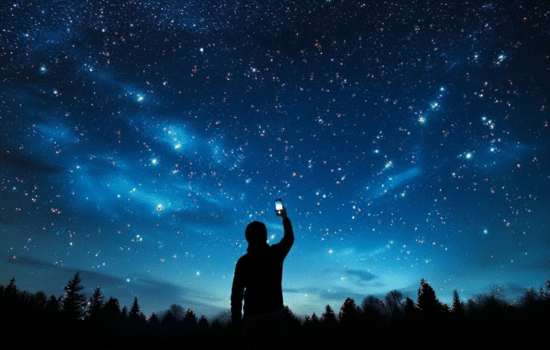Anúncios
The night sky has captivated humanity for millennia, but today’s technology brings the cosmos closer than ever before. Modern smartphone applications transform your device into a powerful astronomical tool.
Whether you’re a seasoned stargazer or just beginning your celestial journey, the right app can revolutionize how you experience the universe. These digital planetariums fit in your pocket, offering real-time star maps, planet tracking, and educational content that makes astronomy accessible to everyone.
Anúncios
🌌 Why Stargazing Apps Have Changed Everything
Gone are the days when amateur astronomers needed expensive equipment and thick reference books to identify celestial objects. Today’s stargazing applications use your smartphone’s sensors, GPS, and augmented reality to provide instant information about anything you point your device toward.
These apps democratize astronomy by removing technical barriers. You don’t need to understand celestial coordinates or memorize constellations. Simply hold up your phone, and the app overlays information directly onto your view of the sky. This intuitive approach makes astronomy engaging for children, students, and curious adults alike.
Anúncios
The educational value extends beyond simple identification. Many applications include detailed information about celestial mechanics, mythological stories behind constellations, upcoming astronomical events, and even notifications for meteor showers or planetary alignments you shouldn’t miss.
⭐ Star Walk 2: Your Personal Sky Guide
Star Walk 2 stands as one of the most visually stunning and user-friendly stargazing applications available. Its beautiful interface combines scientific accuracy with artistic presentation, making each observation session feel magical.
The app uses augmented reality to overlay constellation lines, star names, and celestial objects directly onto your camera view. This feature works remarkably well, even in light-polluted urban environments where you can’t see many stars with the naked eye.
What sets Star Walk 2 apart is its “time machine” feature, allowing you to view the sky at any date in the past or future. Planning to photograph a specific planetary alignment next month? You can visualize exactly where celestial bodies will be and plan accordingly.
The app also includes a comprehensive “What’s New” section that highlights upcoming astronomical events, ensuring you never miss a meteor shower, eclipse, or rare celestial phenomenon. Push notifications can alert you hours before events occur, giving you time to find a good viewing location.
🪐 SkySafari: The Professional’s Choice
For those who want to dive deeper into astronomy, SkySafari offers an unparalleled database of celestial objects. The app contains information on over 120,000 stars, planets, moons, and deep-sky objects in its basic version, with premium versions expanding that to millions.
SkySafari’s interface is more technical than casual stargazing apps, but this complexity serves serious enthusiasts well. The app can control compatible telescopes, turning your smartphone into a sophisticated observatory control system.
The search functionality is exceptional. You can look up specific objects, filter by type, brightness, or visibility, and create custom lists for observation sessions. This organization helps you maximize your stargazing time by planning what to observe before heading outside.
Educational content within SkySafari includes detailed descriptions of celestial objects, their discovery history, and scientific significance. The app also features orbit simulations, showing you how planets and moons move through space in three-dimensional visualizations.
🌠 Stellarium Mobile: Desktop Power in Your Pocket
Stellarium has long been the gold standard for desktop planetarium software, and the mobile version brings that same power to smartphones. The app renders realistic skies with accurate star positions, atmospheric effects, and even shooting stars.
The realism extends to how the app displays the landscape horizon, which changes based on your location. This attention to detail helps you understand exactly what you’ll see from your viewing position, accounting for terrain, buildings, and other obstructions.
Stellarium Mobile excels at showing deep-sky objects like nebulae, galaxies, and star clusters. The app includes high-quality images from space telescopes, allowing you to see what these objects actually look like beyond the tiny dots visible through most amateur telescopes.
Customization options are extensive. You can adjust the magnitude limit to simulate different viewing conditions, toggle constellation artwork from various cultures, and configure the interface to show as much or as little information as you prefer.
🔭 NASA App: Beyond Stargazing
While not exclusively a stargazing app, NASA’s official application deserves mention for anyone interested in space. It provides access to thousands of images, videos, and information about NASA missions, both current and historical.
The app’s “Watch the Skies” section alerts you to visible spacecraft passes, including the International Space Station. There’s something uniquely thrilling about watching the ISS glide across the sky, knowing people are aboard that moving point of light.
Real-time data streams from NASA missions let you follow current space exploration activities. Whether it’s Mars rover updates, solar observation data, or Earth science measurements, the app connects you directly to ongoing research and discovery.
The educational content is exceptional, with articles, podcasts, and videos explaining complex astronomical concepts in accessible language. It’s an excellent complement to stargazing apps, providing context and deeper understanding of what you’re observing.
🌙 Night Sky: Augmented Reality Excellence
Night Sky pushes augmented reality capabilities further than most competitors. The app seamlessly blends digital information with your camera view, creating an immersive experience that feels natural and intuitive.
One standout feature is the “Sky View” mode, which removes all interface elements, leaving only constellation lines and object labels floating in space. This minimalist approach reduces distractions and creates a meditative stargazing experience.
Night Sky includes social features that let you share discoveries with friends and family. You can capture AR screenshots showing labeled constellations and planets, making it easy to document and share your astronomical observations on social media.
The app’s “Tonight’s Best” feature analyzes current conditions and recommends the most interesting objects to observe based on visibility, brightness, and position. This guidance is particularly helpful for beginners who might feel overwhelmed by the vastness of options.
🌍 How to Get the Most from Stargazing Apps
Using these apps effectively requires more than just downloading and opening them. Calibrating your phone’s compass and gyroscope ensures accurate alignment between the digital sky map and the real sky above you. Most apps include calibration instructions in their settings.
Screen brightness becomes crucial during observation sessions. Your eyes need time to adapt to darkness for optimal sky viewing, but bright screens destroy night vision. Enable red-light mode in your chosen app, which preserves night adaptation while remaining readable.
Learning to interpret app displays takes practice. Start with easily identifiable objects like the Moon, bright planets, or prominent constellations. As you build confidence, progress to more challenging targets like star clusters and distant galaxies.
Optimal Conditions for Mobile Stargazing
Location significantly impacts your stargazing success. Light pollution from cities washes out fainter stars and celestial objects. While apps can show what’s theoretically visible, traveling to darker areas dramatically improves actual observations.
Weather conditions matter immensely. Clear skies are obviously necessary, but humidity, temperature, and atmospheric stability all affect visibility. Some apps integrate weather forecasts specifically designed for astronomers, predicting “seeing conditions” and cloud cover.
Moon phase affects stargazing differently depending on your goals. A full moon illuminates the landscape beautifully but makes fainter objects harder to see. New moon periods offer the darkest skies for observing distant galaxies and nebulae.
📱 Combining Apps for Enhanced Experience
No single application does everything perfectly, so many enthusiasts use multiple apps in combination. You might use Star Walk 2 for casual identification while keeping SkySafari for detailed planning and telescope control.
Pairing stargazing apps with photography applications can help you capture what you observe. Long-exposure camera apps designed for astrophotography work alongside star charts to help frame and identify objects in your images.
Weather and light pollution apps complement stargazing tools by helping you choose optimal observation times and locations. Knowing when clear, dark skies will occur lets you plan stargazing sessions in advance rather than hoping for good conditions.
🎓 Educational Benefits Beyond Entertainment
These applications serve as powerful educational tools for students and lifelong learners. They make abstract astronomical concepts tangible by showing planetary motion, star lifecycles, and celestial mechanics in interactive formats.
Teachers increasingly incorporate stargazing apps into science curricula, using them for homework assignments, field trips, and classroom demonstrations. The immediate feedback and visual nature of these apps engage students more effectively than textbooks alone.
For parents, stargazing apps provide opportunities for quality time with children while fostering curiosity about science. Identifying constellations together, watching for satellites, and learning about planets creates memorable experiences that inspire future learning.
🚀 The Future of Mobile Astronomy
Augmented reality capabilities continue improving as smartphone hardware advances. Future apps will likely offer even more realistic overlays, better low-light camera integration, and more sophisticated object recognition.
Artificial intelligence integration promises personalized learning experiences that adapt to your knowledge level and interests. Apps might automatically suggest progression paths, guiding you from basic constellation identification to advanced astrophotography techniques.
Collaborative features will likely expand, connecting amateur astronomers globally to share observations, verify discoveries, and contribute to citizen science projects. Your smartphone could become a node in a worldwide observation network.
✨ Making Astronomy a Regular Practice
Consistency transforms casual stargazing into a rewarding hobby. Setting aside regular observation times, even just 15 minutes weekly, builds knowledge progressively. Apps with notification features help maintain this consistency by reminding you of interesting events.
Keeping an observation journal, whether digital or physical, enhances learning by creating a personal record of discoveries and observations. Many apps include built-in logging features, but a separate journal allows for reflection and personal notes.
Joining astronomy communities, both online and local, provides motivation and shared knowledge. Many stargazing apps connect to social platforms where you can discuss observations, share tips, and learn from experienced astronomers.

💫 Your Window to the Cosmos Awaits
Modern stargazing applications represent a remarkable convergence of ancient wonder and cutting-edge technology. They make the universe accessible to anyone with curiosity and a smartphone, removing barriers that once kept astronomy restricted to specialists.
Each app offers unique strengths, whether that’s Star Walk 2’s beautiful interface, SkySafari’s comprehensive database, or Stellarium’s desktop-quality rendering. Experimenting with different options helps you find the perfect match for your interests and experience level.
The night sky holds endless wonders waiting for discovery. With these powerful tools literally at your fingertips, you can explore nebulae billions of light-years away, track planets as they orbit the Sun, and connect with the cosmos in ways previous generations could only dream about. The universe is calling—all you need to do is look up and open the right app.
